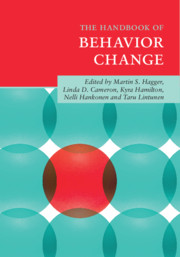Book contents
- The Handbook of Behavior Change
- The Handbook of Behavior Change
- Copyright page
- Dedication
- Contents
- Figures
- Tables
- Sidebars
- Contributors
- 1 Changing Behavior: A Theory- and Evidence-Based Approach
- Part I Theory and Behavior Change
- Part II Methods and Processes of Behavior Change: Intervention Development, Application, and Translation
- Part III Behavior Change Interventions: Practical Guides to Behavior Change
- 31 Attitudes and Persuasive Communication Interventions
- 32 Self-Efficacy Interventions
- 33 Imagery, Visualization, and Mental Simulation Interventions
- 34 Affect-Based Interventions
- 35 Autonomy-Supportive Interventions
- 36 Incentive-Based Interventions
- 37 Monitoring Interventions
- 38 Goal Setting Interventions
- 39 Planning and Implementation Intention Interventions
- 40 Self-Control Interventions
- 41 Habit Interventions
- 42 Economic and Behavioral Economic Approaches to Behavior Change
- 43 Dyadic Behavior Change Interventions
- 44 Social Identity Interventions
- 45 Motivational Interviewing Interventions
- 46 The Science of Behavior Change: The Road Ahead
- Index
- References
35 - Autonomy-Supportive Interventions
from Part III - Behavior Change Interventions: Practical Guides to Behavior Change
Published online by Cambridge University Press: 04 July 2020
- The Handbook of Behavior Change
- The Handbook of Behavior Change
- Copyright page
- Dedication
- Contents
- Figures
- Tables
- Sidebars
- Contributors
- 1 Changing Behavior: A Theory- and Evidence-Based Approach
- Part I Theory and Behavior Change
- Part II Methods and Processes of Behavior Change: Intervention Development, Application, and Translation
- Part III Behavior Change Interventions: Practical Guides to Behavior Change
- 31 Attitudes and Persuasive Communication Interventions
- 32 Self-Efficacy Interventions
- 33 Imagery, Visualization, and Mental Simulation Interventions
- 34 Affect-Based Interventions
- 35 Autonomy-Supportive Interventions
- 36 Incentive-Based Interventions
- 37 Monitoring Interventions
- 38 Goal Setting Interventions
- 39 Planning and Implementation Intention Interventions
- 40 Self-Control Interventions
- 41 Habit Interventions
- 42 Economic and Behavioral Economic Approaches to Behavior Change
- 43 Dyadic Behavior Change Interventions
- 44 Social Identity Interventions
- 45 Motivational Interviewing Interventions
- 46 The Science of Behavior Change: The Road Ahead
- Index
- References
Summary
Behavior change interventions based on self-determination theory focus on promoting autonomous motivation, using autonomy support to do so. This chapter outlines the autonomy-supportive intervention program (ASIP), which helps supervisors “upgrade” the quality of their motivating style toward those they supervise, as occurs in the classroom, workplace, home, sport arenas, and health care settings. This is an important approach to behavior change because, when supervisors become more autonomy-supportive and less controlling, those they supervise tend to increase their adaptive behaviors (e.g., learning, prosocial behavior) and well-being as well as to decrease their maladaptive behaviors (e.g., disengagement, antisocial behavior) and ill-being. This chapter defines the key constructs and practices featured in the ASIP (i.e., supervisor’s motivating styles, supervisee’s psychological needs); identifies the theoretical basis and the specific mechanisms by which this intervention enables behavior change; provides an overview of what occurs during an ASIP; outlines the evidence base supporting the efficacy and benefits of the intervention; and offers step-by-step guidelines for how practitioners might carry out an ASIP in different contexts and populations.
Keywords
- Type
- Chapter
- Information
- The Handbook of Behavior Change , pp. 510 - 522Publisher: Cambridge University PressPrint publication year: 2020



